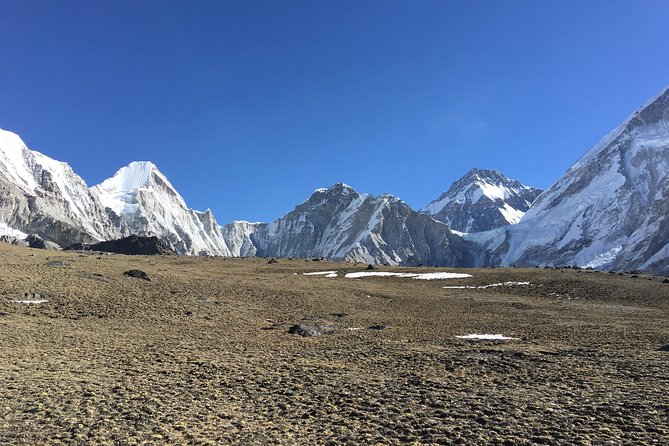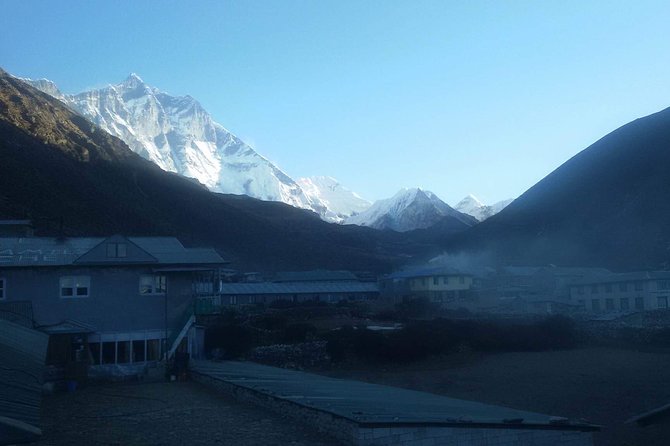Embarking on the Everest Base Camp Trek is a once-in-a-lifetime experience that takes trekkers on a captivating journey through Nepal’s Himalayan landscapes. This 15-day adventure offers awe-inspiring views of snow-capped peaks, glaciers, and high-altitude passes, led by experienced guides and Sherpa porters. Beyond the stunning scenery, the trek allows for immersion in Sherpa culture, interaction with locals, and witnessing of traditional rituals. While the trek presents a challenging yet rewarding experience, the included gear, accommodations, and meals ensure a comfortable and seamless adventure. Delving deeper into the details of this remarkable trek might just inspire your next high-altitude expedition.
Key Points
- The 15-day Everest Base Camp Trek in Nepal offers trekkers the opportunity to explore the awe-inspiring Himalayan landscapes and reach the iconic base camp.
- The trek is led by an experienced guide and accompanied by Sherpa porters, who carry the group’s gear, allowing trekkers to hike at their own pace.
- The package includes domestic airfare, permits, essential gear, and all meals, providing a comfortable and seamless adventure experience.
- Highlights of the trek include the thrilling landing at Lukla Airport and the opportunity to immerse in Sherpa culture and traditions.
- Travelers should ensure proper physical fitness, obtain comprehensive travel and medical insurance, and invest in durable, high-quality hiking gear for the trek.
Trip Overview

Embarking on the Everest Base Camp Trek in Kathmandu, Nepal, adventurers can expect a 15-day journey trekking through the awe-inspiring Himalayan landscapes to reach the iconic base camp at the foot of the world’s highest mountain.
Led by an experienced guide and accompanied by Sherpa porters, the trek offers magnificent views of snow-capped peaks, glaciers, and high-altitude passes.
Accommodations, meals, and essential gear like a sleeping bag, down jacket, and duffle bag are all included, ensuring a comfortable and well-supported experience.
Along the way, trekkers will have the opportunity to enjoy the rich Sherpa culture, creating lasting memories of their Everest adventure.
Ready to hit more trails? More hiking adventures we feature in Kathmandu
Highlights of the Trek
The trek offers several notable highlights, including the thrilling landing at Lukla Airport, considered one of the world’s most challenging mountain airstrips. Trekkers appreciate the convenience of having porters carry their gear, allowing them to hike at their own comfortable pace within a private small group. Throughout the journey, the experienced guide expertly organizes the logistics, ensuring a seamless and well-supported adventure.
| Highlights |
|---|
| Landmarking Lukla Airport landing |
| Porters carry gear, guide organizes logistics |
| Trek at your own pace with a private small group |
| Views of mountain peaks, glaciers, and high-altitude passes |
| Experiencing Sherpa culture |
Included in the Package

This Everest Base Camp Trek package includes a comprehensive suite of amenities and services to ensure a seamless and well-supported adventure.
It covers the necessary domestic airfare, permits, and registrations, as well as the provision of essential gear like down jackets and sleeping bags.
Experienced English-speaking guides and Sherpa porters are on hand to organize logistics and carry your gear, allowing you to trek at your own pace with a private small group.
The package also includes all meals, a first-aid medical kit, and covers permits, taxes, and company service charges.
With these inclusions, you can focus on soaking in the breathtaking Himalayan vistas and enjoying the local Sherpa culture during this unforgettable journey.
Excluded From the Package
While the Everest Base Camp Trek package covers a wide range of inclusions, there are certain expenses that travelers must account for separately. International airfare to and from Nepal isn’t included, nor are Nepal visa fees. Travelers must also arrange for their own travel and medical insurance, as well as cover the costs of any necessary emergency evacuations.
Plus, personal expenses such as those incurred at bars, for beverages, hot showers, laundry, and the like aren’t part of the package. Lastly, the package doesn’t cover any costs that may arise from natural calamities or unforeseen mishaps during the trek.
Some additional exclusions include:
- International airfare
- Nepal visa fees
- Travel and medical insurance
Considerations for Travelers

Embarking on the Everest Base Camp Trek requires careful consideration from prospective travelers. Trekkers should ensure they possess the necessary physical fitness and accliimate properly to the high-altitude environment. Obtaining comprehensive travel and medical insurance is also crucial, as it provides coverage for potential emergencies, including the need for evacuation. Plus, travelers must secure proper hiking gear and equipment, as the trek involves navigating rugged terrain and harsh weather conditions.
| Considerations | Recommendations |
|---|---|
| Physical Fitness | Engage in regular cardiovascular exercise and strength training |
| Acclimatization | Gradually increase altitude to allow the body to adapt |
| Insurance Coverage | Obtain policies that cover medical emergencies and evacuation |
| Gear and Equipment | Invest in durable, high-quality hiking boots, layers, and trekking poles |
- Everest Base Camp Helicopter Tour Stop at Everest View Hotel
- Private Kathmandu Sightseeing Tour – UNESCO World Heritage Sites
- Everest Base Camp Helicopter Tour Landing at Hotel Everest View
- 14-Day Private Annapurna Base Camp Trek
- Everest Base Camp Trek-12 Days
- 200 Hours Yoga Teacher Training at Nepal Yoga Home (Starts on 1st of Everymonth)
Booking and Confirmation
Booking the Everest Base Camp Trek is a straightforward process that involves several key steps. Prospective trekkers can secure their spot by contacting the tour operator directly, either through their website or by phone, and providing the necessary personal and trip details.
Once the initial booking is confirmed, travelers will receive further information regarding the trek’s itinerary, gear requirements, and logistical arrangements.
The booking process typically includes:
- Submitting a deposit to reserve the trek date
- Arranging international and domestic flights
- Providing personal information for permit and registration purposes
With the booking confirmed, trekkers can look forward to embarking on their Everest Base Camp adventure with confidence and peace of mind.
Transportation and Logistics
The Everest Base Camp trek involves several key transportation and logistical considerations to ensure a seamless journey.
Travelers will start their adventure with a domestic flight from Kathmandu to Lukla Airport, often called the world’s most dangerous airport due to its challenging landing conditions.
During the trek, porters will carry the group’s gear, allowing trekkers to hike at their own pace.
The trek also includes an Everest National Park entry permit and Trekkers Information Management System (TIMS) registration, which are essential for accessing the region.
With an experienced English-speaking guide and Sherpa porters leading the way, explorers can focus on seeing the stunning Himalayan landscape and Sherpa culture.
Sherpa Culture and Experience
Trekkers on the Everest Base Camp journey can expect to enjoy the rich Sherpa culture, gaining insights into their way of life and traditions.
The Sherpas, an ethnic group indigenous to the high-altitude regions of the Himalayas, have a deep-rooted connection to the mountains and play a vital role in supporting the trek.
Trekkers will have the chance to:
- Observe Sherpa villages and gain an understanding of their daily lives, customs, and spiritual beliefs
- Interact with Sherpa porters and guides, learning about their expertise in navigating the treacherous terrain
- Visit Tibetan Buddhist monasteries and witness traditional rituals and ceremonies that have been passed down for generations
The Sherpa culture adds an authentic and culturally enriching dimension to the Everest Base Camp experience.
Frequently Asked Questions
What Is the Average Group Size for the Trek?
The average group size for this private trek is small, typically ranging from 2 to 6 participants. The guide organizes the logistics and porters carry the gear, allowing trekkers to explore at their own pace in a more intimate setting.
Is There an Option to Extend the Trek Duration?
Yes, the trek duration can be extended. Many tour operators offer flexible itineraries that allow trekkers to add extra days for acclimatization or to explore more of the Himalayas at their own pace.
Can I Bring My Own Trekking Gear Instead?
You can certainly bring your own trekking gear instead of using the gear provided. This allows you to use equipment you’re familiar with, but you’ll need to ensure it meets the trek’s requirements. The tour operator can advise on suitable gear if needed.
How Difficult Is the Acclimatization Process During the Trek?
The acclimatization process can be challenging, as trekkers need to gradually ascend to higher altitudes to allow their bodies to adjust. Proper pacing and rest days are crucial to prevent altitude sickness and ensure a safe and enjoyable trek.
Are There Any Age Restrictions for the Everest Base Camp Trek?
The Everest Base Camp trek does not have strict age restrictions, but it requires a good level of physical fitness. Younger and older trekkers can participate, but should consult with their guide or a doctor to ensure they can handle the high-altitude demands.
Recap
The Everest Base Camp Trek offers an unforgettable journey through Nepal’s stunning Himalayan landscapes. Trekkers can expect breathtaking mountain views, immersion in Sherpa culture, and a comfortable, guided experience led by experienced professionals.
With essential gear, accommodations, and meals included, this trek provides an opportunity to challenge oneself while exploring one of the world’s most iconic destinations. Whether a seasoned adventurer or a first-time trekker, the Everest Base Camp Trek promises an unforgettable adventure.
More Hiking & Trekking Tours in Kathmandu
More Tour Reviews in Kathmandu
Not for you? Here's more things to do in Kathmandu we have recnetly reviewed
- 2 Best Guided Tours In Jagat
- 20 Best 2 Day Tours In Kathmandu
- 20 Best 3 Day Tours In Kathmandu
- 20 Best 4 Day Tours In Kathmandu
- 8 Best Dining Experiences In Kathmandu
- 20 Best Full-Day Tours In Kathmandu
- 25 Best Helicopter Flights And Tours In Kathmandu
- 25 Best Helicopter Flights And Tours In Kathmandu
- 13 Best Massage And Relaxation Services In Kathmandu
- 5 Best Photography Experiences In Kathmandu
- 8 Best Dinner Tours In Kathmandu
- 17 Best Lunch Experiences In Kathmandu
